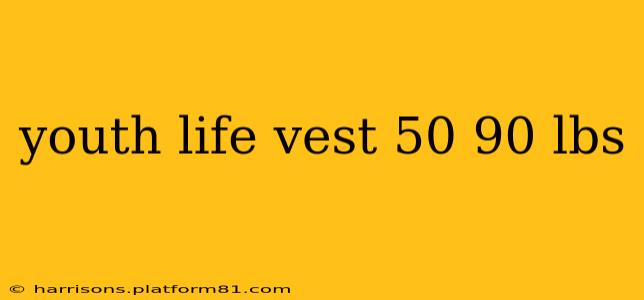Choosing the right life vest for your child is crucial for their safety on the water. With weight ranges varying between manufacturers, finding a life vest suitable for a 50-90 lb youth can be tricky. This guide breaks down the key considerations to ensure you select the perfect fit and optimal safety for your child.
What Type of Life Vest Do I Need for a 50-90 lb Child?
For children weighing between 50 and 90 pounds, you'll generally be looking at Type III personal flotation devices (PFDs). These are often referred to as "vest-style" PFDs and are designed for calm waters. They provide good buoyancy and freedom of movement, making them ideal for activities like boating, kayaking, and fishing. It is crucial to check the weight range specified on the life vest itself, as this can vary significantly between brands and models. Don't rely solely on age recommendations; always prioritize the weight range.
How Do I Determine the Correct Size for My Child?
Accurate weight is paramount. Weigh your child before purchasing a life vest to ensure a proper fit. A life vest that's too small won't provide adequate buoyancy, while one that's too large can be cumbersome and potentially dangerous. Look for clear and easily understandable sizing charts on the packaging or manufacturer's website.
What are the features of a good youth life vest?
A well-designed youth life vest should include several key features:
- Secure and Adjustable Fit: Look for adjustable straps and buckles that allow for a snug but comfortable fit. The life vest shouldn't be too tight or too loose. Proper adjustment ensures it stays in place even during activity.
- Bright Colors: High-visibility colors like orange, yellow, or red make your child easily visible on the water, enhancing safety.
- Durable Materials: Choose a life vest made from durable, water-resistant materials that can withstand wear and tear.
- Approvals and Certifications: Verify that the life vest meets the standards set by the Coast Guard or equivalent international bodies. Look for the appropriate certification label.
- Comfort Features: Consider comfort elements like soft materials against the skin, especially important for prolonged wear.
What are the different types of life vests for kids?
While Type III PFDs are common for this weight range, other types exist:
- Type I (Offshore Life Vest): Offers the highest level of buoyancy and is designed for rough waters. Usually not necessary for recreational activities in calm waters for this weight range.
- Type II (Nearshore Buoyant Vest): Provides good buoyancy and is suitable for calm waters, but might be a bit bulky for some children.
- Type V (Special Use Devices): These are designed for specific activities, like inflatable life vests for kayaking or waterskiing. Often not suitable for general use.
What is the difference between a life vest and a life jacket?
The terms "life vest" and "life jacket" are often used interchangeably and generally refer to the same type of PFD. However, technically, "life jacket" might sometimes indicate a more traditional, less form-fitting style.
How do I know if my child's life vest is the right fit?
Once you've chosen a life vest, perform a fit check:
- Proper Buoyancy: The life vest should keep your child's head above water when they are face-up in the water.
- Snug Fit: The life vest shouldn't ride up or shift during movement.
- Comfortable Movement: Your child should be able to move their arms and legs freely.
- Secure Fasteners: All straps and buckles should be securely fastened.
Remember, ensuring your child's safety on the water is paramount. By carefully selecting a properly fitting life vest and understanding the different types available, you'll provide them with the best possible protection. Always check the manufacturer's instructions for proper use and care.
